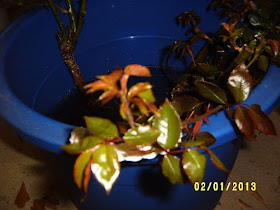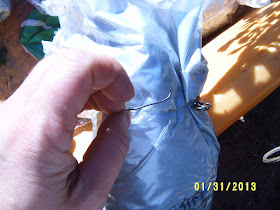If you have never read my blog before this day, I want you to know I am a beginner. (People who do read it, are probably tired of seeing that but I put up detailed pictures so I don't want to make it seem like I know what I am doing). This is my first experience with bare roots (well, I have three weeks experience) . So the details described is what I did, it my be wrong. If this is a new post, pay attention to the comments. If you are reading this is a long past archive, search for more recent posts to see if this work.
This a continuation of yesterday. I bought 21 bare root roses. They averaged $6.00 a plant . These roses will cost me $17.00 on average per plant if I wait longer in the season. So it was much more economical and a great rationalization to buy many up front.
The following is a step by step on how I am going to prepare them for soaking overnight and planting tomorrow. I do not know how long they can stay in the buckets, but it's a good assumption...not forever.
This was huge mass of bare roots I just purchased yesterday.
 |
| Some of the bare roots are in peat pot, in a bag. |
 |
| I discovered when you purchase bare roots, you can peel off the sticker telling what it is. |
 |
| Next, I add epsom salt to the bucket. The instructions read 1/2 cup per gallon, that you read about in the link.. I was more conservative and added, less thant that, oftemtime a prink. |
I am very guilty of trying to save packaging at the expense of the plant. Like wanting to save the other stickers of this rose, or trying to save a pot at the expense of the plant in the pot....so I gently rip the plastic off. If you see how the roots look under this, you would learn to be careful how tightly you grasp the bare roots especially at the but union...it not eggshell but you could do some damage I bet.
Now when you take off the packaging you will probably find brown paper and saw dust. For the record, most of these bare roots have wax on them. I remember reading about that and I don't remember the significance. I will look it up but I think it's to stop them from growing and I suppose the wax comes off in the sun or heat? Will look that up.
Next, you will see a bunch of saw dust. Notice I am wearing a glove. Some roses could be used as weapons...like the JFK roses I purchased...so wear gloves...promise you want to.
 |
| I shook off the saw dust to expose the roots. |
 |
| WOOHOOOOO!!! JACKPOT....there were two bear root roses in one package of these Gypsy.....man, my lucky day!!!! Nope, I inspected, these two grafts, and if they arent, they are now. |
 |
| Put the plant in the bucket with the epsom salt at the bottom. |
 |
| Add water up the bud union. but not over ...I just wanted to make sure the roots were all able to soak. |
 |
| I grouped the same plants, like these three climbing golden showers in the same bucket, with a sticker on it. |
 |
| Bare roots soaking....notice the sticker on the bucket...this is very important. When you purchase large amounts of bare roots,. it's important know which is which |
Some of bare roots came in peat pots, I don't have enough sunlight hours to prep the site. All the plants are being put in the garage evening because it was wanting to dip down into the thirties tonight. I could put them in the greenhouse but the garage is more stable. I feel like this is stressful enough to them that I don't want to add temperature swings. The plants that in peat pots I punctured a hole in the plastic.
The soil seemed dry. Unlike the bags, the peat pots plants are in soil. But anyway, there were dry so I put some water through the hole.
The Next Morning............
 |
| Everyone looked happy.....I could now tell the differences in the foliage...and now understand what they mean by dull leaves or leathery leaves. |
 |
| These are the climbing golden showers. Their leaves really do look like leather. |
The plants looked very happy this morning. I know I am personifying them...but I don't care....
I found this website, and I like the instructions...I may do half the amounts recommended....because I'm skiddish and think its better to do too little than too much.
Sigh, reading the instructions it mentions that the mushroom compost is probably a bad idea because it's fresh...exchanging it for hen manure.....it's better to get it right the first time.
Just hope the bare roots I planted so far in it won't be hurt.
8:17 am. Went to co-op to exchange the mushroom for hen. The lady, Dina, there I seek for advice almost weekly. When I explained to her what I was about to do, and that the mushroom compost might burn the plants....she said "BULL****" She isn't proned to curse but she was vehement. She said, dig your hole, mix in the mushroom compost until you get the right texture and plant your plant. Blood meal will burn your plant. I knew that blood meal could and I, honestly didn't want to dig that big of a hole...so I am going to do as she suggested. I drove back with the mushroom compost in my trunk. Sore from all the work I had done, and my body complaining about all the work I was gonna do, but I will dig a big hole, mix in compost and good soil, and then water. It just seemed easier. Maybe I am being lazy, but it's simple..











Didn't they perk up quickly?
ReplyDeleteThomasville Rose Garden 2010
The photos lack spaces between. I got tired of trying to separate them. Wordpress gets on my last nerve sometimes.
There is not an in-depth study because these were just hurried photos on our way to see the native azaleas. I think we were killing time before Susie and I were to meet Ms. Julie for lunch in town.
I would tend to agree with Ms. Dina.
ReplyDeleteThose roses are beautiful, and forgive me if I am tired. Are those your roses or Ms. Julie's? I love, love, love the spanish moss...I have it all over the property. In any event, I would show them off all the time if I were you.
ReplyDeleteThe roses soaking did but I don't think they like to be in sunshine when they are soaking, so I put them back in the shade. I loved your post about epsom salt. Dina didn't approve of epsom salt, or at least not now, and I am not going to give the new bare roots any but I did put a quarter cup roughly for them to soak in...I felt it was a conservative compromise. The other plants that were established that I feel like I gave to much, are still doing well....poor plants, what an ignorant care taker they have.
ReplyDeleteThe pictures are from the City of Thomasville Rose Garden. They have more than 500 roses in the Garden and then there are rose beds all over the city. When I first worked in Thomasville was the first time I'd seen beds devoted to nothing but roses -- no edging plants, no companions, just beds of roses with pine straw mulch.
ReplyDeleteIn Atlanta, they combine roses with lilies, perennials and lots of pretties. Thomasville is the Rose City and they do nothing but roses.
Mistakes are how you learn. Mostly the Epsom salts will just sit there or leach away if the plant didn't feel it needed to take it up. If your soil was overly acid and there was cups full of Epsom salts you might bind up some other nutrients.
Make careful notes of what you put where so you can go back later and compare.
How exciting to have 22 new rose babies! Good luck planting them out. Be extremely careful around the tiny little roots - these are the feeder roots and they give the plant the ability to take up water and survive. I can't wait to see your garden when it's all blooming!
ReplyDeleteOkay, for us rose dummies, what are the feeder roots...is that the tiny ones...and what are the big ones called?
ReplyDelete